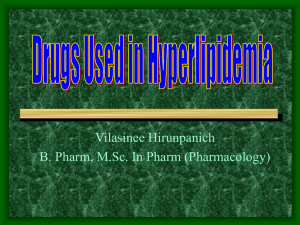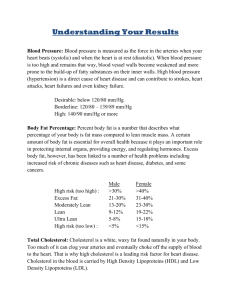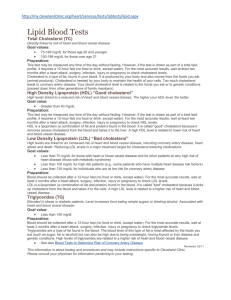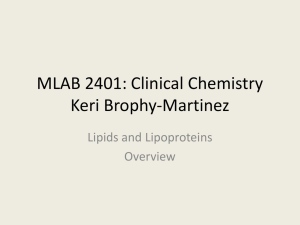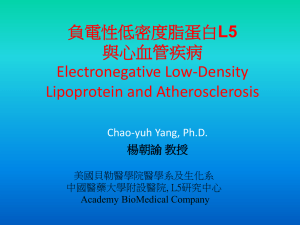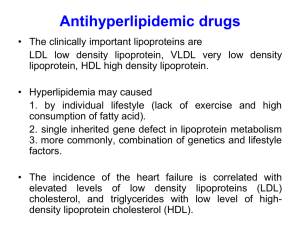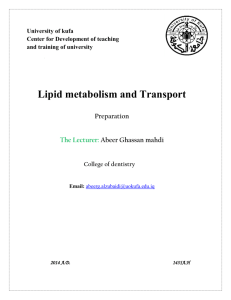Prof. Walter KK Ho - The Chinese University of Hong Kong
advertisement
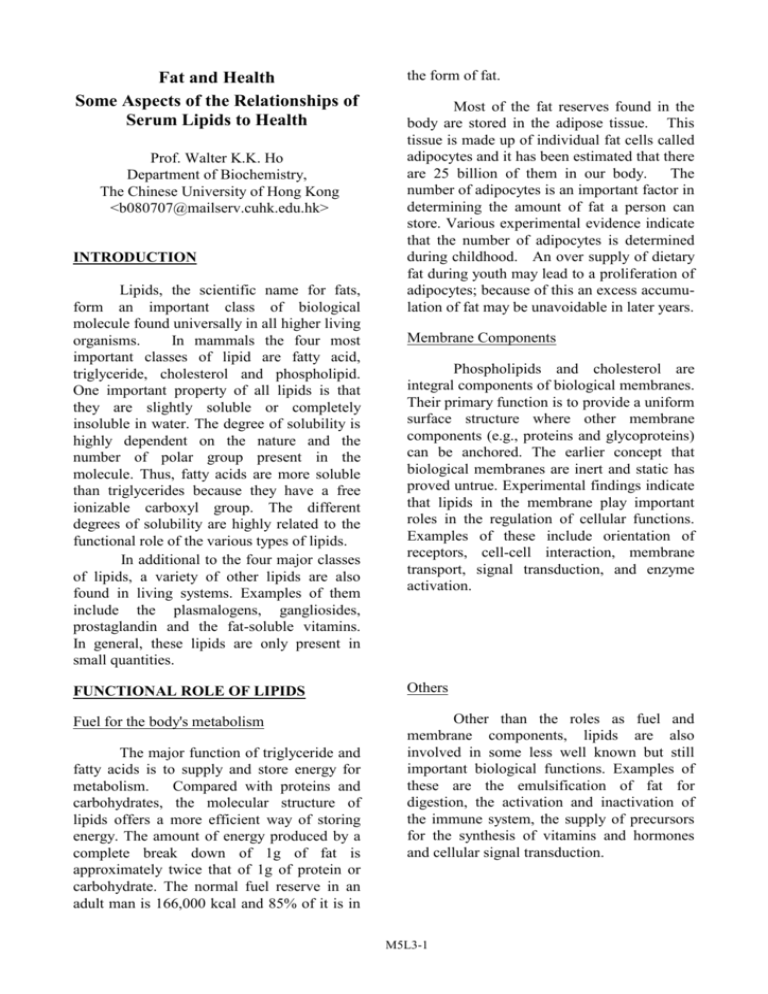
Fat and Health Some Aspects of the Relationships of Serum Lipids to Health Prof. Walter K.K. Ho Department of Biochemistry, The Chinese University of Hong Kong <b080707@mailserv.cuhk.edu.hk> INTRODUCTION Lipids, the scientific name for fats, form an important class of biological molecule found universally in all higher living organisms. In mammals the four most important classes of lipid are fatty acid, triglyceride, cholesterol and phospholipid. One important property of all lipids is that they are slightly soluble or completely insoluble in water. The degree of solubility is highly dependent on the nature and the number of polar group present in the molecule. Thus, fatty acids are more soluble than triglycerides because they have a free ionizable carboxyl group. The different degrees of solubility are highly related to the functional role of the various types of lipids. In additional to the four major classes of lipids, a variety of other lipids are also found in living systems. Examples of them include the plasmalogens, gangliosides, prostaglandin and the fat-soluble vitamins. In general, these lipids are only present in small quantities. the form of fat. Most of the fat reserves found in the body are stored in the adipose tissue. This tissue is made up of individual fat cells called adipocytes and it has been estimated that there are 25 billion of them in our body. The number of adipocytes is an important factor in determining the amount of fat a person can store. Various experimental evidence indicate that the number of adipocytes is determined during childhood. An over supply of dietary fat during youth may lead to a proliferation of adipocytes; because of this an excess accumulation of fat may be unavoidable in later years. Membrane Components Phospholipids and cholesterol are integral components of biological membranes. Their primary function is to provide a uniform surface structure where other membrane components (e.g., proteins and glycoproteins) can be anchored. The earlier concept that biological membranes are inert and static has proved untrue. Experimental findings indicate that lipids in the membrane play important roles in the regulation of cellular functions. Examples of these include orientation of receptors, cell-cell interaction, membrane transport, signal transduction, and enzyme activation. FUNCTIONAL ROLE OF LIPIDS Others Fuel for the body's metabolism Other than the roles as fuel and membrane components, lipids are also involved in some less well known but still important biological functions. Examples of these are the emulsification of fat for digestion, the activation and inactivation of the immune system, the supply of precursors for the synthesis of vitamins and hormones and cellular signal transduction. The major function of triglyceride and fatty acids is to supply and store energy for metabolism. Compared with proteins and carbohydrates, the molecular structure of lipids offers a more efficient way of storing energy. The amount of energy produced by a complete break down of 1g of fat is approximately twice that of 1g of protein or carbohydrate. The normal fuel reserve in an adult man is 166,000 kcal and 85% of it is in M5L3-1 TRANSPORTATION OF LIPIDS In mammals as well as in other vertebrates the site of lipid absorption or synthesis may not be the site of metabolism and storage. Thus, lipid absorbed in the intestine must somehow be transported through the circulatory system to other organs. Since lipids are not soluble in aqueous systems, a means of transport is required and is provided by a class of macromolecules named the serum lipoproteins. The lipoproteins are basically complexes of proteins and lipids. By virtue of the ability of the proteins to interact with both lipid and water, lipids can be solubilized and transported in the bloodstream in lipoprotein form. Thus, without lipoproteins, the transportation of lipids may be impaired. A typical example of this is the case of abetalipoproteinemia. Patients affected with this disease cannot synthesize lipoprotein and because of this there is an accumulation of fat in both the liver and the intestine. Classification of the serum lipoproteins Human serum lipoproteins are generally classified into four major categories. They are the chylomicrons, the very low density lipoproteins (VLDL), the low density lipoproteins (LDL) and the high density lipoproteins (HDL). Chylomicrons Chylomicrons are the largest of the serum lipoproteins. They are secreted mainly by the gastro-intestinal tract during the absorption of dietary fat. Chemically, chylomicrons are composed predominantly of triglyceride with smaller amounts of phospholipid, unesterified cholesterol, cholesteryl ester and proteins. The size of chylomicrons ranges from 750 to 10,000 Å with molecular weights between 1,000 to 10,000 million daltons. Because of their large size, chylomicrons are easily seen as a milky emulsion in the serum after a fatty meal. Very low density lipoproteins (VLDL) VLDL are triglyceride rich particles derived mainly from the liver. The main function of this class of lipoprotein is the transport of liver triglyceride to peripheral tissue for storage or metabolism. The chemical composition of VLDL is predominantly triglyceride with smaller amounts of phospholipid, cholesterol and protein. The hydrated density of VLDL is between 0.95 to 1.006 gm/ml and the molecular weight is between 5 to 6 million daltons. Data from electron microscopy indicates that the VLDL particle is spherical with diameters ranging from 300 to 800 Å. Low density lipoproteins (LDL) Serum LDL are characterized by their high cholesterol content, particularly in the form of cholesteryl ester. This class of molecule is derived mainly from the breakdown of VLDL during which hydrolysis of VLDL-triglyceride occurs. The physiological function of LDL appears to be related to cholesterol transport. It has been suggested that the development of atherosclerosis (a process whereby blood vessels get clotted up with fiberous cholesterol deposits) is significantly related to increased blood level of this class of lipoproteins. The chemical composition of LDL is approximately 25% protein, 10% triglyceride, 8% unesterified cholesterol, 37% cholesteryl ester and 22% phospholipid. Physical features defining this class of lipoproteins include hydrated density ranging from 1.006 to 1.063 gm/ml, molecular weight from 2.1 to 2.6 million daltons and a mean diameter of 212 Å. High density lipoproteins (HDD) Serum HDL are the smallest of all the major lipoproteins. They are made up of approximately 50% protein and 50% lipid. Of the lipid components present, phospholipid and cholesteryl ester predominate. The source of HDL is believed to be the liver. Since part of the protein moiety in HDL is common with VLDL there may be a metabolic connection between them. The risk M5L3-2 of atherosclerosis has been found to be inversely related to the concentration of HDL. It has been hypothesized that these lipoproteins may act as carrier to transport cholesterol from peripheral tissue to the liver for metabolism. Physically, the size of the HDL particles ranges from 75 to 100 Å with molecular weights from 200,000 to 400,000 daltons. The hydrated density of HDL is between 1.063 and 1.21 gm/ml. HDL has been subdivided into two classes, HDL2 and HDL3. The beneficial effect of HDL in reverse cholesterol transport appears to be associated with HDL3. Absorption and transportation of dietary fat A major source of fat is from dietary intake. Absorption of fat occurs in the intestine. Fat is first emulsified into small micelles by the action of bile salts and then hydrolyzed by the action of various enzymes from the pancreas. Triglyceride is first broken into free fatty acids and monoglycerides while cholesteryl esters and phospholipids are broken down into fatty acids, free cholesterol and phosphoglycerol. The fatty acids and other lipid components are then absorbed into the mucosal cells of the intestine. The exact mechanism of this uptake is unknown. Once inside the intestinal cells, lipid components are reassembled back into triglyceride, cholesteryl ester and phospholipid. Subsequently, triglyceride together with a small amount of phospholipid, cholesteryl ester and cholesterol are complexed to a specific protein (B-protein) in the endoplasmic reticulum to form chylomicrons. The chylomicrons are transported to the other side of the intestinal cells and ejected into the lymphatic system. All chylomicrons thus secreted will gradually enter the bloodstream via the thoracic duct. Since the chylomicrons are very large particles, their presence in the blood will produce a milky appearance. This phenomenon can usually be observed two hours after a fatty meal. Once inside the bloodstream, the chylomicrons are transported to the adipose tissue where their triglyceride moiety is broken down into fatty acids and monoglyceride by the action of an enzyme, lipoprotein lipase. The fatty acids and monoglycerides are absorbed into the adipocytes. Triglyceride is resynthesized inside the cells and stored as fat droplets. Chylomicrons which are not picked up by the adipose tissue will be metabolized by the liver and their lipid moiety resecreted in the form of VLDL. Transportation of endogenous fat Although the bulk of fat in the body comes directly from the diet, there are situations in which other dietary components, viz., carbohydrate, can be converted to fat in the liver and stored in the adipose tissue. This phenomenon usually comes about when there is an excess of caloric intake. The transport of triglyceride from the liver to the adipose tissue is the main function of VLDL. VLDL are synthesized in the liver very much the same way as chylomicrons are synthesized in the intestine. VLDL is secreted into the bloodstream directly from the liver and then transported to the adipose tissue. Like the chylomicrons, VLDL is broken down by lipoprotein lipase. The fatty acids released are absorbed, reassembled into triglyceride and stored in the form of fat droplets. As the process of triglyceride removal continues, the VLDL particles become smaller and smaller with their relative cholesterol content increasing. Eventually, these particles will be transformed into intermediate LDL and LDL . Transportation of cholesterol In contrast to triglyceride, the reason why cholesterol transport is required in the bloodstream is still by and large unknown. Cholesterol is an important component of biological membranes, therefore it is present in almost every organ. Most tissues have the capability to synthesize cholesterol but do not possess the ability to metabolize or degrade it. Thus, it has been hypothesized that some form M5L3-3 of transportation system is required to channel peripheral cholesterol to the liver for breakdown and excretion. Since the LDL and HDL are the major carriers of cholesterol in the bloodstream, it has been suggested that they may play a crucial role in channeling cholesterol from one organ to another. As HDL is believed to play a crucial role in reverse cholesterol transport to the liver, its level in the blood stream has gained wide medical attention as a negative risk factor for development of CHD. blood products, fibrous tissue and calcium deposits) and associated changes in the media or middle portion of the arterial wall. Atherosclerosis is a continuous process throughout life and normally it will not lead to any clinical symptoms until the fourth decade. The risk of atherosclerosis has been shown to associate with smoking, high blood pressure, physical inactivity and elevated serum cholesterol level. Of the four factors mentioned, the elevation of serum cholesterol is believed to be the most direct cause because cholesterol is a major component in the hardened areas (called plaques) of the arteries. The lipid theory of atherosclerosis LIPIDS AND HEALTH As mentioned in the Introduction, lipids are involved in maintaining a number of vital functions in our body. Because of this, the inability to synthesize or absorb lipid will undoubtedly affect our general health. For example the storage of triglyceride in the adipose tissue provides us the necessary energy supply during starvation. If our body does not have such a vital fuel reserve, mobilization of protein may be necessary. Because proteins are important components of cellular functions, the deprivation of proteins during starvation may lead to permanent cellular and tissue damage. As in the case of lipid deficiency, an abundance of lipids in our circulatory system and adipose tissue can also affect our health. In contrast to starvation, this aspect of overnutrition has become a major health problem in modern industrial societies. Atherosclerosis Atherosclerosis is the process usually referred to as hardening of the arteries. Basically it is a form of degenerative change in the inner lining (intima) of the arteries. There is focal accumulation of lipids (with or without complex carbohydrates, blood and The cause of atherosclerosis has been under active investigation in the past 50 years. The interest in the process is probably due to the high incidence of diseases, such as coronary heart disease and stroke, caused by it. At the moment, a number of theories have been proposed to account for the events leading to the development of atherosclerosis. However, none of them have been proven to be adequate and acceptable. The lipid theory proposes that the basic mechanism of atherosclerosis is due to the infiltration of serum lipids into the intimal layer of the arterial wall. There are 3 events that are key to the formation of early atherosclerotic lesions. The first is infiltration of LDL particles through the endothelium into the intimal layer of the blood vessel wall. The LDL particles are then oxidized. Macrophages in the intima can ingest a limited number of LDL particles through their normal LDL receptor. However, once LDL is oxidized, the uptake is increased significantly and not regulated. This leads to the formation of foam cells in the intima. Foam cells are a major component of the early atherosclerotic lesion. The accumulation of monocytes and macrophages is also critical in the formation of an early atherosclerotic lesion. Endothelial cells express glycoproteins that allow monocyte adhesion to the endothelial surface. Oxidized LDL stimulates endothelial cells to produce a monocyte hemotactic factor. As a result, monocytes enter the intima and differentiate into macrophages. These M5L3-4 macrophages produce cytokines that stimulate endothelial cells to produce adhesive glycoproteins and thus recruiting more monocytes. Macrophages also produce growth factors that result in the proliferation of smooth muscle cells. The combination of these events result in the formation of a fatty streak or early atherosclerotic lesion. Since the initial and subsequent events are positively related to serum LDL concentration, it is not surprising that many epidemiological studies performed in the past 30 years have already established that a high cholesterol level means high risk in the development of coronary heart disease. Fig. 1 summarizes the different stages of atherosclerosis leading to the final outcome of a blocked artery in coronary or stroke patients. Figure 1 Potential routes of treatment The treatment of atherosclerosis can be divided into two phases, prevention and cure. In the case of prevention, measures are taken before the development of any signs or symptoms. Examples of preventive treatment include low fat low cholesterol diet, intake of monounsaturated fat, keeping the body weight within normal range, exercise, no smoking and frequent monitoring of serum lipid levels. In contrast to prevention, there is presently no good method to reverse the process of atherosclerosis once it is developed. Potentially, there are means by which one can manipulate the serum lipoprotein transportation system to halt or reverse this process. For example, the drug lovastatin, an inhibitor of a key enzyme in the synthesis of cholesterol, can be used to reduce serum cholesterol level by up to 30%. Clinical use of this drug as well as other cholesterol lowering drug has provided evidence that if serum cholesterol could be maintained at a low level (e.g. below 200 mg/100ml) the course of atherosclerosis can actually be reversed. In recent years, the concept of preventing LDL from oxidation has also gained wide attention in the treatment of atherosclerosis. Since the infiltration of oxidized LDL into the intima is believed to be the initiation process of atherosclerotic lesion, the intake of food or drug that can prevent oxidation appears to be an attractive means of slowing down such a process. In a number of clinical studies, the intake of greater than 100 units of vitamin E per day has been shown to be beneficial. Modern surgical procedures have also played an important role in the treatment of coronary blood vessel blockage due to atherosclerosis. The two most common techniques used are coronary by-pass surgery and angioplastin. In the former, the surgeon graft a vein from the leg and construct a bypass blood vessel in the heart so that blood can flow over the blocked area. In the latter, a balloon catheter is inserted into the blocked blood vessel and pressure is applied to crush the plaque into small pieces to restore full blood flow. Although both of these procedures have saved millions of patients from dying from heart attacks, they cannot prevent the course of atherosclerosis. Therefore, a healthy living style is still the best method in keeping our blood vessels clear. SELECTED REFERENCES Connor, W. E. (1968) Dietary sterols: Their relationship to atherosclerosis. J. Am. Dietetic Assoc. 52: 202-208. Brewer, H. B., Gregg, R. E., Hoeg, J. M. and Fojo, S. S. (1988) Apolipoproteins and lipoproteins in human plasma: an overview. M5L3-5 Clin. Chem. 34/8(B): B4-b8. McGill, H. C. (1988) The pathogenesis of atherosclerosis. Clin. Chem. 34/8B: B33-B39. Brown M. S. and Goldstein, J. L. (1986) A receptor-mediated pathway for cholesterol homeostasis. Science 232: 34-47. Muldoon, M. F., Manuck, S. B. and Matthows, K. A. (1990) Lowering cholesterol concentrations and mortality: a quantitative review of primary prevention trials. Brit. Med. J. 301: 309-314. Diaz, M. N., Brei, B., Vita, J. and Keaney, J. F. (1997) Mechanisms of disease: antioxidants and atherosclerotic heart disease. New Engl. J. Med. 337: 408-416. M5L3-6

